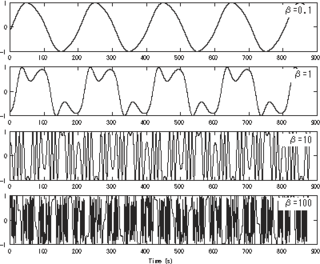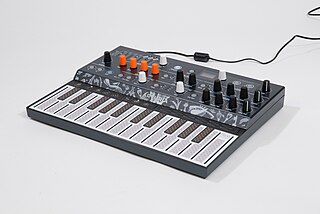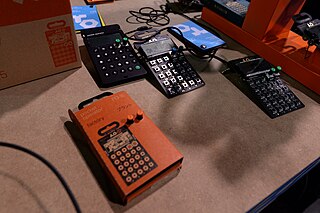
Frequency modulation synthesis is a form of sound synthesis whereby the frequency of a waveform is changed by modulating its frequency with a modulator. The (instantaneous) frequency of an oscillator is altered in accordance with the amplitude of a modulating signal.

An analog synthesizer is a synthesizer that uses analog circuits and analog signals to generate sound electronically.

The Moog Taurus is a foot-operated analog synthesizer designed and manufactured by Moog Music. It was originally conceived as a part of the Constellation series of synthesizers. The initial Taurus I was manufactured from 1975 to 1981, followed by a less popular redesign, Taurus II, followed from 1981 to 1983. Instead of a conventional keyboard, the Taurus uses an organ-style pedal board similar to the pedal keyboard of a spinet organ. This control method was chosen because the Taurus was intended to be played by foot while the player's hands played one or more keyboards, although it was often used by guitarists. While the original Taurus featured its own synthesis engine, the Taurus II was essentially the same as the Moog Rogue. In 2010, Moog issued the Moog Taurus III which closely emulates the analog circuitry of the Taurus I, in addition to adding some modern features.
The Nord Lead is a series of virtual analog subtractive synthesizers, manufactured by Clavia.
Phase distortion (PD) synthesis is a synthesis method introduced in 1984 by Casio in its CZ range of synthesizers. In outline, it is similar to phase modulation synthesis as championed by Yamaha Corporation, in the sense that both methods dynamically change the harmonic content of a carrier waveform by influence of another waveform (modulator) in the time domain. However, the application and results of the two methods are quite distinct.
Elektron is a Swedish developer and manufacturer of musical instruments founded in 1998, as well as having its headquarters, R&D and production in Gothenburg, Sweden. They produce mainly electronic musical instruments, but have also made effects units and software. Since 2012, there have been branch offices in Los Angeles and in Tokyo.

The Korg OASYS is a workstation synthesizer released in early 2005, 1 year after the successful Korg Triton Extreme. Unlike the Triton series, the OASYS uses a custom Linux operating system that was designed to be arbitrarily expandable via software updates, with its functionality limited only by the PC-like hardware.

The Access Virus is a virtual analog synthesizer made by the German company Access Music GmbH. It was first produced in 1997 and has since been upgraded frequently, with the company releasing new models about every two years. Early models include the Virus A, Virus B, and Virus C series, each available in various hardware configurations. In November 2005, the Virus TI series was released, including the 61-key Virus TI Keyboard and the 37-key Virus TI Polar. A small desktop model was released in February 2008 called the Virus TI Snow. A revision of the TI series called TI2 came out in March 2009, featuring faster digital signal processing (DSP) controllers, additional polyphony, more effects in the effect section and a slightly changed design. The Virus series also has come out with two software plugin versions: TDM for Pro Tools and VST for TC Electronic Powercore series. The term Access Virus can be used to refer to any one of these synthesizers.
Synapse Audio Software is a software company located in Germany. Previously known as Sonic Syndicate and headed by Richard Hoffmann, they develop music production software for the Mac OS and Microsoft Windows platforms. They started developing software in November 1998 as Sonic Syndicate and changed their name to Synapse Audio with the release of Orion Platinum in 2002.
Polyphony is a property of musical instruments that means that they can play multiple independent melody lines simultaneously. Instruments featuring polyphony are said to be polyphonic. Instruments that are not capable of polyphony are monophonic or paraphonic.
Linear arithmetic synthesis, or LAsynthesis, is a means of sound synthesis invented by the Roland Corporation when they released their D-50 synthesizer in 1987.

A synthesizer is an electronic musical instrument that generates audio signals. Synthesizers typically create sounds by generating waveforms through methods including subtractive synthesis, additive synthesis and frequency modulation synthesis. These sounds may be altered by components such as filters, which cut or boost frequencies; envelopes, which control articulation, or how notes begin and end; and low-frequency oscillators, which modulate parameters such as pitch, volume, or filter characteristics affecting timbre. Synthesizers are typically played with keyboards or controlled by sequencers, software or other instruments and may be synchronized to other equipment via MIDI.
The Roland Alpha Juno is a series of analog polyphonic synthesizers introduced by Roland Corporation in 1985. The Alpha Juno 1 and Alpha Juno 2 were released at the same time, and feature the same sound engine but with the latter boasting additional performance features. The Alpha Junos were a departure from their predecessor, the Roland Juno-106, as they replaced the dedicated controls with soft touch buttons and a single dial for programming sounds. One of the factory presets, nicknamed a 'hoover sound', became a staple in jungle and rave music.

The AX80 is a polyphonic analogue keyboard synthesizer manufactured by Akai Professional in 1984. It was Akai's first venture into the professional electronic musical instrument market. The AX80 used digitally controlled oscillators (DCO) and filter circuitry based on the Curtis Electronics CEM 3372 integrated circuit. It was marketed as part of a line of project studio equipment called the Akai Music Studio System, which included the S612 digital sampler the MR16 drum machine, the MS08 sequencer, and the MG1212 multitrack tape recorder, at a price of $1,695 US.

The CZ series is a family of low-cost phase distortion synthesizers produced by Casio in the mid-1980s. Eight models of CZ synthesizers were released: the CZ-101, CZ-230S, CZ-1000, CZ-2000S, CZ-2600S, CZ-3000, CZ-5000, and the CZ-1. Additionally, the home-keyboard model CT-6500 used 48 phase distortion presets from the CZ line. The CZ synthesizers' price at the time of their introduction made programmable synthesizers affordable enough to be purchased by garage bands. Yamaha soon introduced their own low-cost digital synthesizers, including the DX-21 (1985) and Yamaha DX100, in light of the CZ series' success.

Teenage Engineering is a Swedish consumer electronics company and manufacturer founded in 2005 by Jesper Kouthoofd, David Eriksson, Jens Rudberg and David Möllerstedt and based in Stockholm. Its products include electronics and synthesizers, with its core product being the OP-1, as well as instant cameras.

The Arturia MiniBrute is a synthesizer manufactured by Arturia. Although the MiniBrute was the first piece of analog hardware created by Arturia—which had previously exclusively marketed software synthesizers—it generated strong sales.

The Korg Minilogue is a polyphonic analog synthesizer released in 2016 by Korg. It offers users four-voice polyphony with two analog VCOs per-voice and was designed to be affordable. It was designed by Korg engineer and synthesizer designer Tatsuya Takahashi, who said "the concept of the Minilogue was to build an analog synthesizer that doesn't rely on the fame and success of an old synth".

The MicroFreak is a synthesizer manufactured by French music technology company Arturia and released in 2019. Described as a "Hybrid Experimental Synthesizer", it uses 18 digital sound engines (algorithms) to synthesize raw tones. This digital oscillator is then fed into a multi-mode analog filter, giving the MicroFreak its hybrid sounds.

Pocket Operators are a line of miniature synthesizers, drum machines and grooveboxes, produced by the Swedish company Teenage Engineering. They were originally released in 2015 as a collaborative effort with the clothing brand Cheap Monday. They are inexpensive, with all main line models retailing for under $100. As of 2022, there are nine models in the main series, along with four limited edition models and an app.













